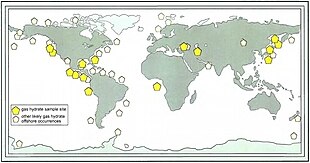

A mud volcano or mud dome is a landform created by the eruption of mud or slurries, water and gases.[1][2][3] Several geological processes may cause the formation of mud volcanoes. Mud volcanoes are not true igneous volcanoes as they do not produce lava and are not necessarily driven by magmatic activity. Mud volcanoes may range in size from merely 1 or 2 meters high and 1 or 2 meters wide, to 700 meters high and 10 kilometers wide.[4] Smaller mud exudations are sometimes referred to as mud-pots.
The mud produced by mud volcanoes is mostly formed as hot water, which has been heated deep below the Earth's surface, begins to mix and blend with subterranean mineral deposits, thus creating the mud slurry exudate. This material is then forced upwards through a geological fault or fissure due to local subterranean pressure imbalances. Mud volcanoes are associated with subduction zones and about 1100 have been identified on or near land. The temperature of any given active mud volcano generally remains fairly steady and is much lower than the typical temperatures found in igneous volcanoes. Mud volcano temperatures can range from near 100 °C (212 °F) to occasionally 2 °C (36 °F), some being used as popular "mud baths".[citation needed]
About 86% of the gas released from these structures is methane, with much less carbon dioxide and nitrogen emitted. Ejected materials are most often a slurry of fine solids suspended in water that may contain a mixture of salts, acids and various hydrocarbons.[citation needed]
Possible mud volcanoes have been identified on Mars.[5]
- ^ Mazzini, Adriano; Etiope, Giuseppe (May 2017). "Mud volcanism: An updated review". Earth-Science Reviews. 168: 81–112. Bibcode:2017ESRv..168...81M. doi:10.1016/j.earscirev.2017.03.001. hdl:10852/61234.
- ^ Kopf, Achim J. (2002). "Significance of mud volcanism". Reviews of Geophysics. 40 (2): 1005. Bibcode:2002RvGeo..40.1005K. CiteSeerX 10.1.1.708.2270. doi:10.1029/2000rg000093. S2CID 21707159.
- ^ Dimitrov, Lyobomir I (November 2002). "Mud volcanoes—the most important pathway for degassing deeply buried sediments". Earth-Science Reviews. 59 (1–4): 49–76. Bibcode:2002ESRv...59...49D. doi:10.1016/s0012-8252(02)00069-7.
- ^ Kioka, Arata; Ashi, Juichiro (28 October 2015). "Episodic massive mud eruptions from submarine mud volcanoes examined through topographical signatures". Geophysical Research Letters. 42 (20): 8406–8414. Bibcode:2015GeoRL..42.8406K. doi:10.1002/2015GL065713.
- ^ "Mars domes may be 'mud volcanoes'". BBC. March 26, 2009. Retrieved 2009-03-27.